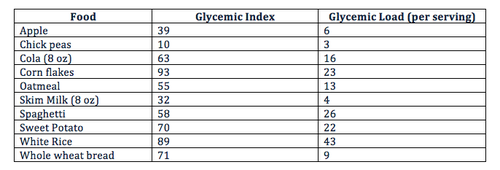You may have heard of the glycemic index (GI). It’s a measure sometimes used as a way to predict the impact of various foods on your blood sugar. Fewer people are familiar with the more worthy judge of carbohydrate quality: glycemic load. Impress your friends with your nutrition savvy and learn the difference between these two buzzwords!
View this free demo to see how InsideTracker can optimize your health and performance.
You have probably heard of blood sugar, also referred to as blood glucose. Glucose is the simplest form of sugar, as it is the major source of energy for the cells in your body. Every time you eat, your body breaks down the carbohydrates, fats and proteins in your meal into smaller particles. Through this process, glucose (the smallest building block of carbohydrates) is released into your bloodstream. Every time you eat a meal, you experience a spike in your blood sugar. Insulin helps lower your blood sugar by cuing your cells to take up the circulating glucose to use or store for energy. Without insulin, blood sugar levels after meals will remain very high. In certain types of diabetes, insulin either not produced or does not function properly and must be injected into the bloodstream.
But Why is High Blood Sugar Such a Big Deal?
In addition to the short-term effects of high blood sugar (fatigue, headaches, etc), chronic hyperglycemia can have serious long-term effects. Over time, high amounts of blood sugar will actually coat your red blood cells. These coated cells impede proper blood circulation and can eventually cause plaque to build up in the blood vessels in your body. The blood vessels in your eyes, kidneys and feet are some of your most vulnerable, which is why symptoms of uncontrolled diabetes often show up in those areas first. Over the longer term, high blood sugar can lead to a whole array of conditions like nerve damage, kidney problems, gum disease, tooth loss, limb amputations, heart attacks, strokes, and eventually death!
Glycemic Index vs. Glycemic Load
To review, the Glycemic Index (GI) for a food is defined as the food’s ability to increase blood glucose 2 hours after consumption. Ingesting pure glucose causes a rapid spike in blood glucose levels and has a GI value of 100. All foods in the index are therefore compared to this reference. High-glycemic foods (like white bread and white rice) digest and absorb into the bloodstream quickly, which causes a rapid increase in blood sugar levels. Low-glycemic foods (like most vegetables) digest and absorb more slowly, which causes a gradual rise in blood sugar and insulin levels.
Here’s a more in depth overview on the Glycemic Index.
One of the biggest flaws of the glycemic index is that it doesn’t take serving size into account. For example, carrots rank rather high on the glycemic index system. However, scientists say that in order to raise your blood sugar, you would have to eat about a pound and a half of carrots. Most of us are probably not eating like that on a regular basis.
Glycemic load (GL) addresses some of the shortcomings of the glycemic index and gives us a better overall picture of the true effect of a certain food on your blood sugar. Glycemic load accounts for both the quality and quantity of carbohydrates in a food, by including the serving size in its formula, as well as the foods glycemic index.
Here’s how you would calculate the glycemic load for an average sweet potato:
Glycemic Index = 70
Grams per serving = 31.4
Glycemic Load = (70 x 31.4) / 100 = 22
Below is a table of GI and GL values for select foods. If the glycemic load for certain foods seems surprising to you, remember that GL is based on serving size. Bigger serving sizes will cause higher glycemic loads.

GLs less than 10 are considered low-GL foods and have little impact on your blood sugar.
GLs between 10 and 20 are moderate-GL foods with moderate impact on blood sugar.
GLs above 20 are high-GL foods that tend to cause blood sugar spikes.
Low-GL foods should be the staples in your diet whereas higher GL foods make better “once in a while” type foods. While both GI and GL can be useful tools to help us make decisions about our diet, it’s important to keep in mind their limitations. Corn flakes and sweet potatoes have similar GL values, but most of us know intuitively that a sweet potato is a better choice for dinner than corn flakes. Sweet potatoes naturally have lots of nutrients, like vitamin A, potassium, and fiber, while corn flakes do not.
Keep your Diet and Blood Sugar On Track
Still a little confused? We’re here for you! Find out with us if your blood sugar and other biomarkers of wellness are in their healthiest ranges! When you purchase a plan from InsideTracker, we’ll give you personalized nutrition, exercise, and lifestyle recommendations to help you reach your optimal health status.
Try Our Free Demo